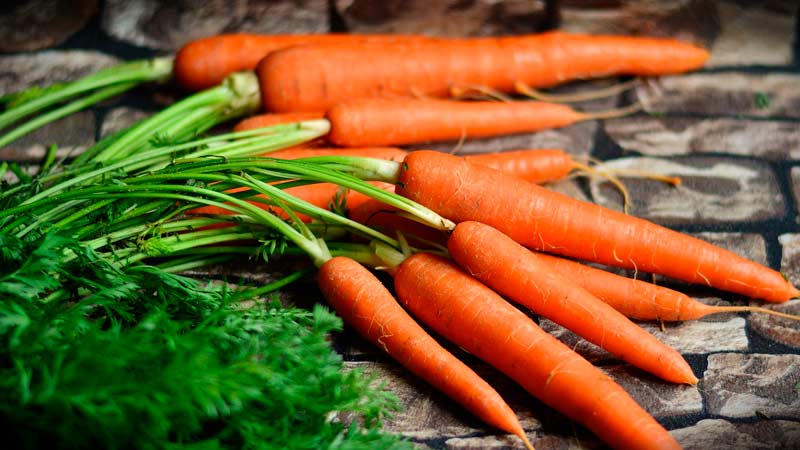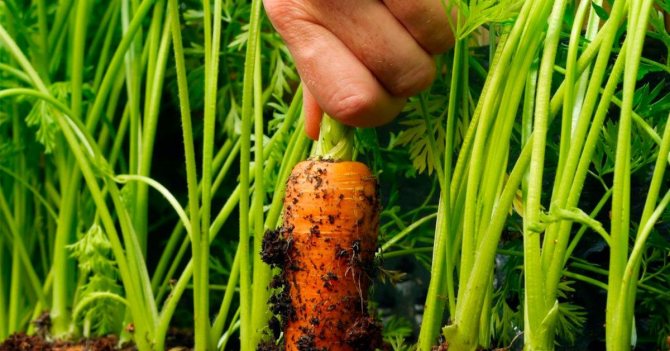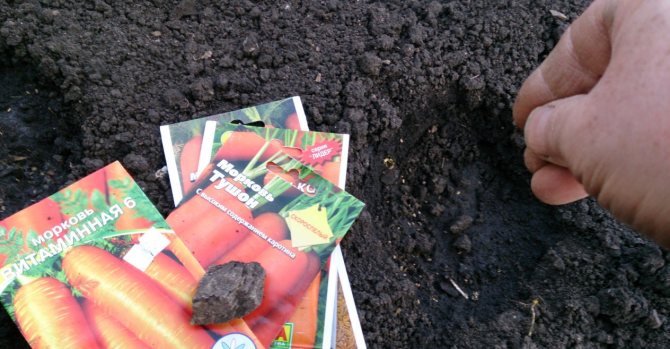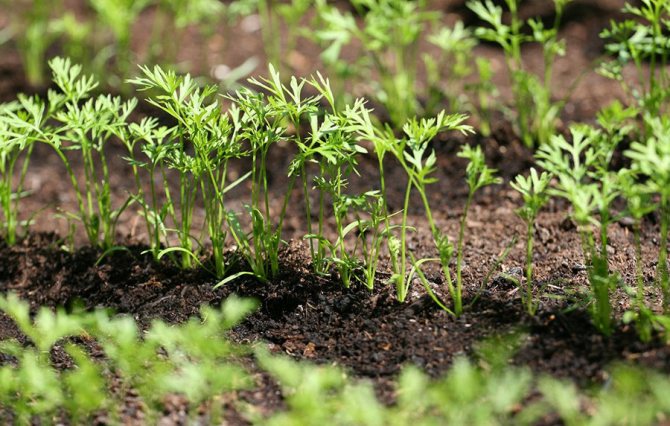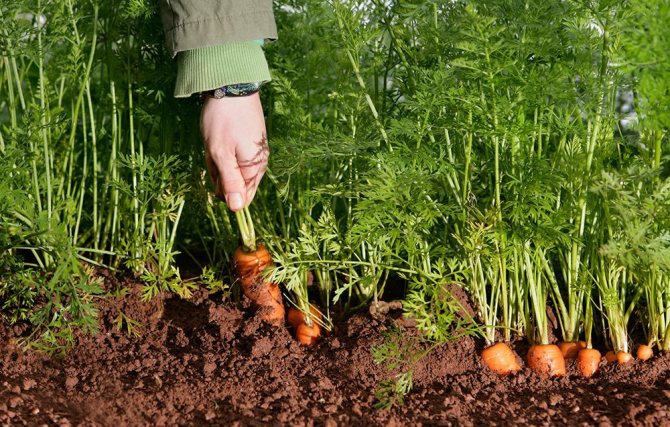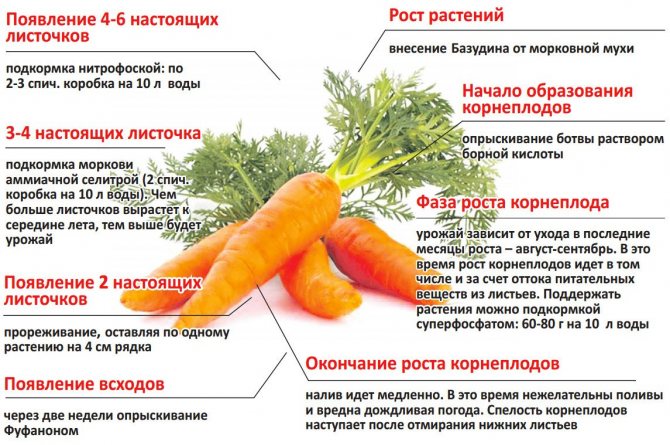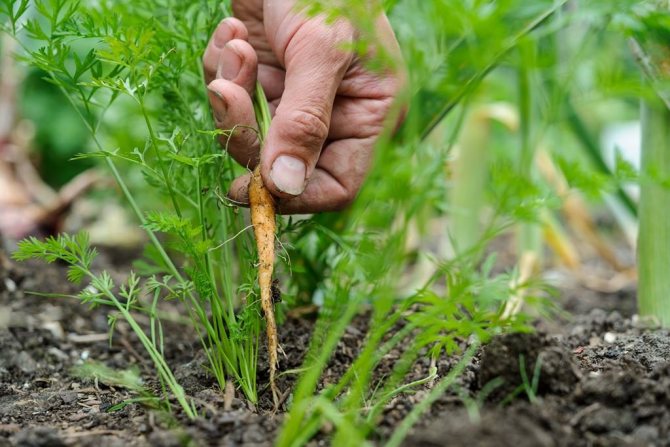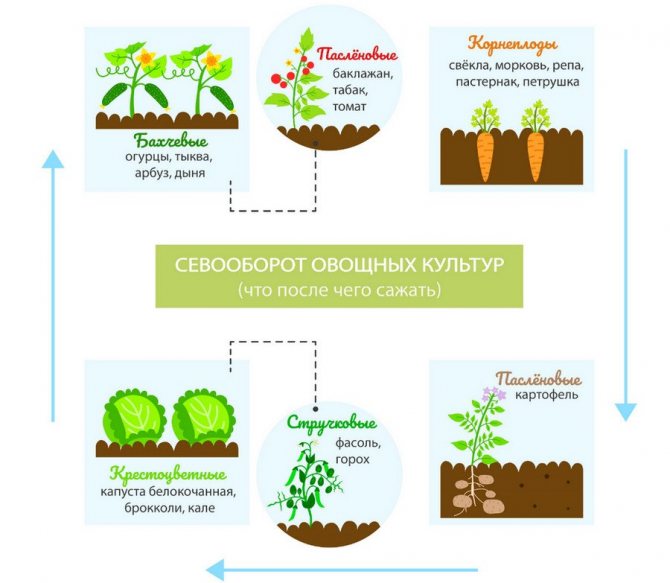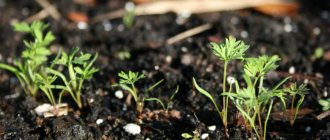How to grow large and sweet carrots
Carrots are one of the most popular root vegetables in modern vegetable gardens. Smooth beds with openwork green leaves adorn the plots of even beginner gardeners. But only those who adhere to the rules manage to get a harvest of beautiful, even root crops. growing carrots.
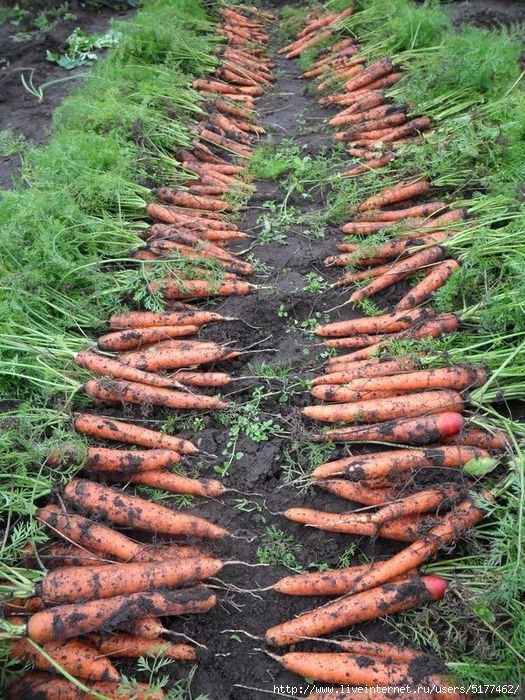
Choosing a location for the garden Carrots should be placed in well-lit areas. Growing in the shade will lead to a significant decrease in yield and a deterioration in taste. Therefore, it is worth allocating an area for carrots, which is in direct sunlight throughout the day.
In addition, it is necessary to take into account the crop rotation - the order of growing crops in a specific area.
It is impossible plant carrots
annually on the same bed or after such plants:
- parsley;
- dill;
- parsnip;
- celery.
The ideal "predecessors" of this root vegetable would be:
- tomatoes;
- cucumbers;
- onion;
- garlic;
- potatoes;
- cabbage.
Sowing dates for carrots Experienced gardeners know how important the correct sowing time is. The yield of root crops directly depends on this. After all, the ripening time of different varieties varies considerably. In addition, it is necessary to focus on the desired harvest time.
To get early carrots, the so-called "bundle production", practice podwinter or spring sowing of early ripening varieties. True, the first option is not possible in all climatic zones. In severe winters, seeds freeze out even under a thick layer of covering material. Therefore, it is better to give preference to early spring crops. They can be carried out immediately after the topsoil has warmed up.
Returning cold snap will negatively affect the level of keeping quality of root crops and can provoke the active formation of flower arrows. But for beam products, these flaws are not a hindrance. That is why early ripening varieties can be sown much earlier.
Carrot varieties with a long ripening period are excellent for storage. But their sowing is recommended to be carried out after a stable heat is established (15-18 ° C).
Seed preparation and sowing Pre-sowing preparation allows you to immediately identify "defective" seeds and accelerates germination. Therefore, you should not neglect this stage. Moreover, the procedure requires almost no effort. First, the seeds must be poured with warm water. In 10 hours all the "illiquid" will emerge.
To speed up germination by a week or even more, you need to carry out one more simple manipulation. The seeds are placed on a damp piece of cloth or cotton and kept there for several days. The air temperature should vary between 20 ° C and 24 ° C. In such conditions, after three days the seeds will hatch - fragile roots will appear.
Before planting carrots, you need to dig out the grooves and moisten them well. They should not be too shallow, so that strong gusts of wind do not spread the seeds throughout the area. Do not make grooves too deep. Otherwise, the seeds will not germinate at all. The optimum planting depth ranges from 2 to 3 cm.The distance between adjacent grooves is at least 15 cm, between seeds - at least 2 cm.
Carrot Garden Care In order for carrots to grow sweet and beautiful, regular soil cultivation should be carried out. The first weeding may be required before the seeds germinate. The proximity of weeds has a detrimental effect on the development of carrots. Therefore, they must be eliminated as soon as they appear.
The soil in the garden bed should always be loose. Compaction of the soil and the formation of a crust provoke the curvature of the root crops. They can grow large, but the appearance will be completely unpresentable. Therefore, loosening the soil in the garden is a mandatory procedure.
To carrots have grown
large, it is necessary to monitor the level of crop thickening. The first thinning is carried out immediately after the real leaves appear on the plants. The distance between adjacent carrots is about 3 centimeters. If the seeds were sown sparsely, then there is no need for the first thinning. When two pairs of leaves appear, the procedure is repeated, increasing the distance between neighboring plants twice.
Watering and fertilizing Juicy, sweet roots grow only in those who spare no effort and time for watering. Lack of moisture is the cause of the bitterness and lethargy of carrots. Moreover, watering is equally important at all stages of plant development. The depth of moistening should correspond to the size of the root crop. A bed of adult carrots must be watered so that the water soaks a layer of 30 cm.
It is enough to feed the carrots twice during the season. The first fertilization should be done 3-4 weeks after germination, the second after a couple of months. It is most convenient to apply fertilizers in liquid form. To do this, add a choice of water to a bucket of water:
- a tablespoon of nitrophoska;
- two glasses of wood ash;
- a mixture of 20 g of potassium nitrate, 15 g of urea and double superphosphate.
Pest and disease control
The main enemy of root crops is the carrot fly. Its presence can be determined by the presence of swirling leaves. The best pest defense is the right one. carrot care.
The insect appears on thickened, overgrown with weeds or excessively damp beds. To combat carrot fly, chemicals are used: Intavir, Actellik and others.
Carrots are slightly susceptible to disease. Most often, problems arise with alternaria or phomosis. Treating the beds with a 1% Bordeaux solution will significantly reduce the risk of developing diseases.
Carrot varieties Among the many varieties of carrots, you can easily choose the best option for both spring and winter sowing. The most productive are:
- Alenka;
- Touchon;
- Nantes;
- Vitamin;
- Queen of Autumn;
- Flakke.
To grow sweet and large carrots, it is important to properly prepare the garden, plant it at the right time, and provide it with the necessary care. Everything about growing a good harvest of carrots: what kind of soil is needed for carrots, three terms of sowing seeds, thinning, feeding and protection from pests.
Factors affecting the quality of the root crop
To get a good harvest of carrots, they need proper care. For example, several factors affect the productivity of a crop and the quality of its fruits.
The predecessors in the garden
The order of growing vegetables in one area plays a significant role. So, ideal crops growing in front of carrots are:
It is forbidden to plant a crop next to:
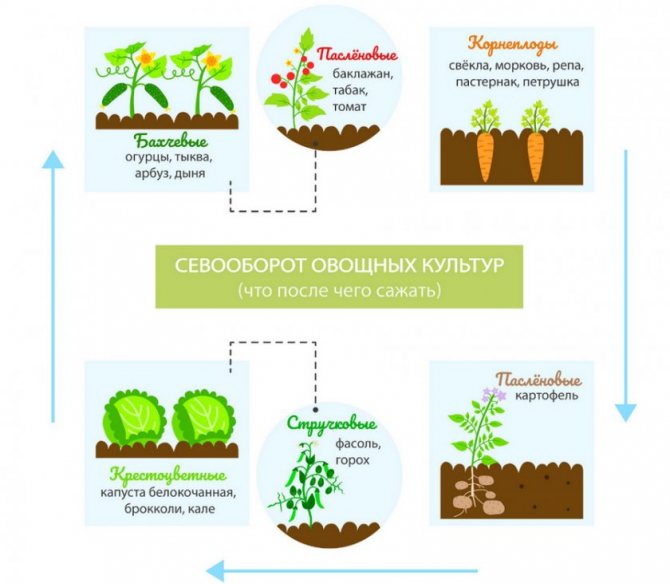

It is not recommended to cultivate carrots in the same place, they are kept for at least 5 years
Seat selection
To grow sweet, tasty carrots, they are planted in a well-lit, level place. Shaded areas will degrade flavor and result in loss of yield.
Soil preparation
An important factor for good yields is the composition of the soil.For growing carrots, light, sandy or loamy soils with a low or neutral acidity level are recommended. On clay, heavy soil, it will not work to grow the desired crop - the roots will grow small and deformed.
A crop grown in the wrong soil will be savory and root-covered. Before spring planting (in autumn), potassium and phosphorus are added to the soil - their lack affects the shape of the fruits, making them ugly and small.
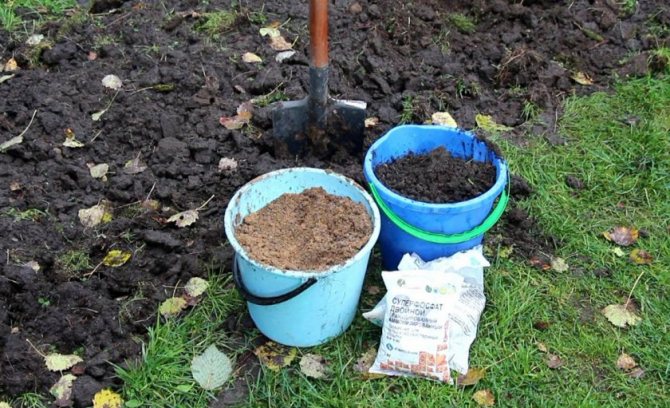

Optimal planting time
In spring, sowing of early ripening carrot varieties is carried out when the soil warms up to + 3 ... + 5 ° C. The first shoots appear within 20-30 days. But experienced gardeners say that the vegetable should be planted at a soil temperature of + 8 ... + 10 ° C. Then the seedlings will hatch on the 12-15th day.
Sowing of winter carrots is carried out in October-November. Such operations are acceptable for the middle zone of the Russian Federation.
Top dressing and watering
So that the future harvest does not have a pale appearance, the plant is regularly watered and fertilized. Watering young plants in clear weather is carried out 1-2 times a week at the rate of 3-4 liters per 1 m². Later, when the carrot grows up, the frequency and intensity of soil moisture is reduced (once a week at the rate of 10–20 liters per 1 m²).
The culture is fed infrequently, only 2-3 times per season. Fertilizing poor soils is especially important. The first introduction of fertilizers is carried out 13-15 days after the emergence of seedlings. Use the following mixture:
- potassium nitrate - 20 g;
- urea - 15 g;
- concentrated phosphorus fertilizer - 15 g;
- water - 10 liters.


The soil is fertilized for the second time after another 13-15 days. Prepare the following composition:
- potassium chloride - 20 g;
- complete mineral fertilizer - 20 g;
- water - 10 liters.
If nitrogen in the soil is insufficient (and this is determined by the poor development of culture and pale foliage), it is fertilized with mullein or bird droppings (1 liter per bucket of water). You can add a little urea to the solution.
Foliar dressing (potassium chloride 30 days before harvest) will help to get a large harvest and increase the keeping quality of fruits.
In addition, make sure that the top of the fruit is not exposed. Otherwise, the accumulation of solanine occurs, and the fruits begin to taste bitter.
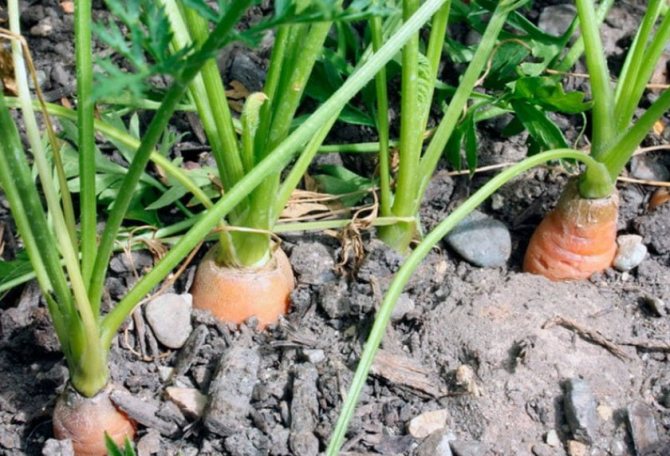

For a sweet crop, you can feed the soil with wood ash (100 g per 1 m²)
Weed and pest control
In order not to wonder why the crop turned out to be unsweetened, you should systematically pay attention to the soil. The proximity of weeds negatively affects root crops, so they are harvested immediately after germination.
In addition, it is imperative to monitor the condition of the plants: pests can not only give the culture an unpresentable look, but also harm the fruits.
The main enemy of culture is the carrot fly. Its presence can be identified by the swirling leaves. The best defense against such a pest is proper care. The insect appears on too thick plantings, overgrown with weeds, or with excessive soil moisture.
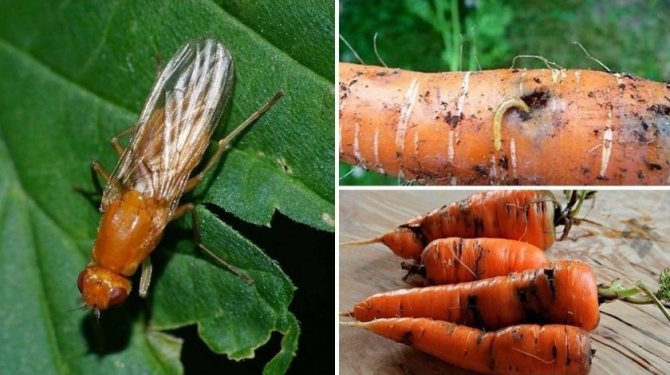

You can get rid of the insect with drugs:
Carrot crops are immune to disease, but they can be attacked by Alternaria or Phomosis. For the prevention of such diseases, plantings are treated with a weak solution of Bordeaux liquid.
How to get a great root crop
If carrots have sprouted poorly in your garden, then most likely you have not looked after them well enough. Statistics show: 90% of carrot seeds do not germinate solely due to drying out of the soil. You need to know: from the moment of sowing, carrot seeds require constant abundant soil moisture.
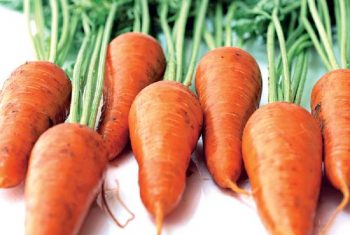

Many factors affect the yield of carrots.
The following recommendations will not interfere with gardeners:
- You should not buy granulated seeds, as they need careful maintenance and constant abundant watering.
- Carrots are sown in slightly thawed soil, when its lower layers are still full of water. This technique makes it possible to water the plants much less often. Cold snap carrots are not terrible - they perfectly tolerate temperatures up to -2-3 degrees.
- Planting carrots early does not affect the shelf life of the fruit. Only the variety of seeds and good storage conditions matter.
- Dry carrot seeds germinate slowly. Therefore, before sowing, you need to either soak them in water, or germinate them.
- After sowing the seeds, the beds must be covered with foil to create condensation. At the edges of the beds, the film is pressed with stones to the ground to protect the seeds from drought and wind.
- Open the film and air the seeds daily. As soon as the first shoots appear, the film must be removed immediately so that the seeds do not suffer from excessive moisture and overheating.
Choosing the best varieties
The size and sweetness of root crops may depend not only on planting care, but also on the variety chosen. After all, not all fruits have the same composition of yellow-orange pigment and sugar.
The largest
All types of carrots store carbohydrates, carotene and other useful elements. But only with the right approach can you get a truly gigantic harvest. The largest fruits are considered to be in excess of 200 g, regardless of the size of the carrots.
The best are:
- Canada F1. Produces even, oblong, conical fruits with a standard weight of 200–250 g and a length of 15–17 cm. The core is bright orange. Main advantages: high productivity and good keeping quality - stored in optimal conditions until the next season, without loss of marketable and taste characteristics. The growing season is 130–135 days. The variety tolerates cooling of the soil and air, it is immune to root rot and some bacterial diseases.
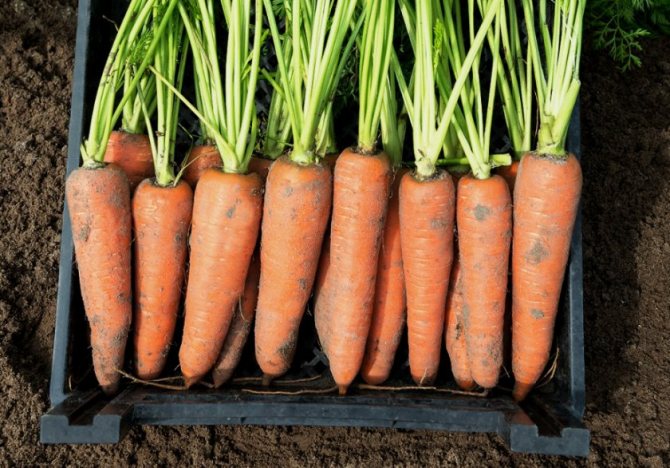

- Nandrin F1. Bred by Dutch scientists specifically for storing vegetables. It is considered the best Dutch hybrid. When sowing seeds in summer, the crop can be harvested as early as September. Fruits grow up to 20-23 cm and weigh about 200 g. Distinctive features - inconspicuous core and the ability to produce crops on different soils. The variety tolerates high humidity and shading of the site.
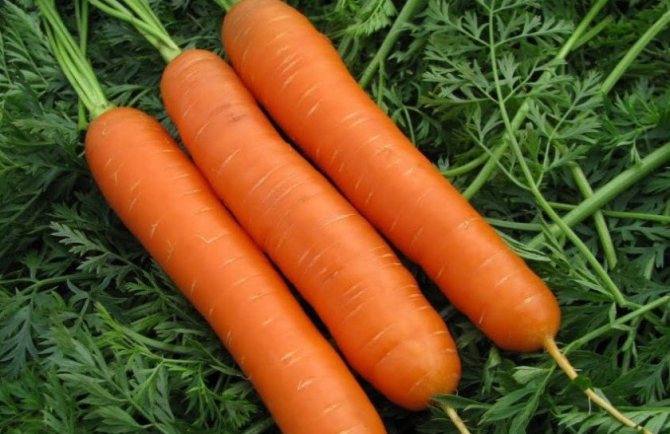

Nantes-4. A hybrid of the Nantskaya variety, adapted for growing in almost all climatic zones of the Russian Federation. High-yielding carrots (8-10 kg per 1 m²). The average weight of a root vegetable is 200 g with a length of 17-19 cm. A characteristic feature is an increased concentration of vitamins and useful components. The ripening period does not exceed 100–112 days.
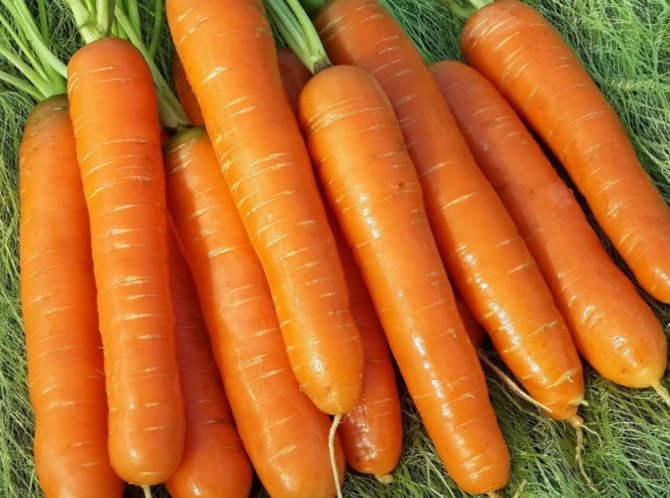

Shantane. Competent care allows you to collect gigantic fruits. Carrots grow in a regular conical shape, with a slightly rounded tip. The disadvantage of the variety is its low resistance to pests, therefore, when caring for Shantan, special attention should be paid to prevention and regular fertilization. Ripening period - 130-140 days, yield - 15 kg per 1 m².
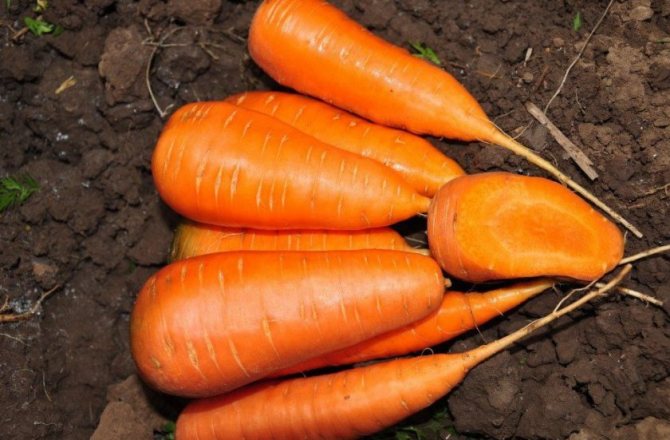

Yellow carrots. The growing season does not exceed 90-100 days. Fruits of regular shape, conical, average weight - 400-450 g. Not suitable for consumption unprocessed, designed for processing (canning, juices, etc.).
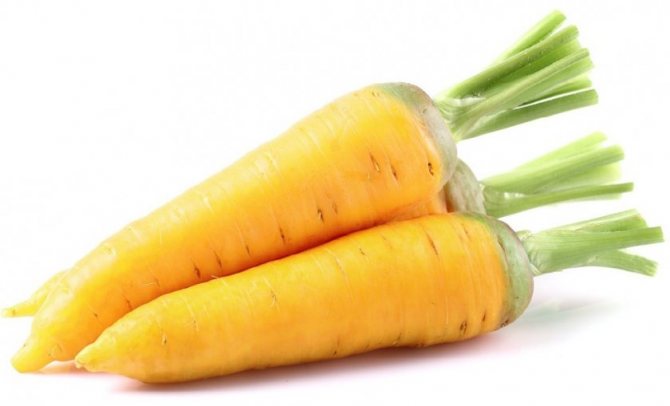

- White carrots. It is characterized by a pleasant aroma and unique taste. Root crops grow up to 350-400 g. Disadvantages - high demands on growing conditions, watering and feeding. In dry times, the fruits decrease in volume.
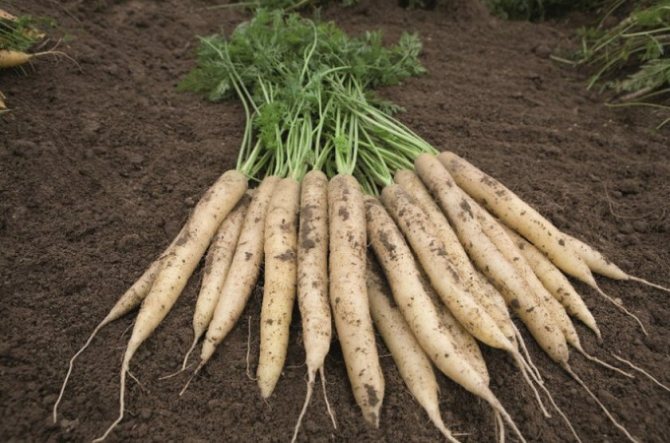

The sweetest
For those looking for the juiciest and sweetest variety, the following options are offered:
- Maestro F1.An early ripening hybrid designed for growing in any climatic zone. The main condition is frequent watering. The color of the fruit is rich orange, cone-shaped. The variety stands out for its resistance to characteristic diseases.
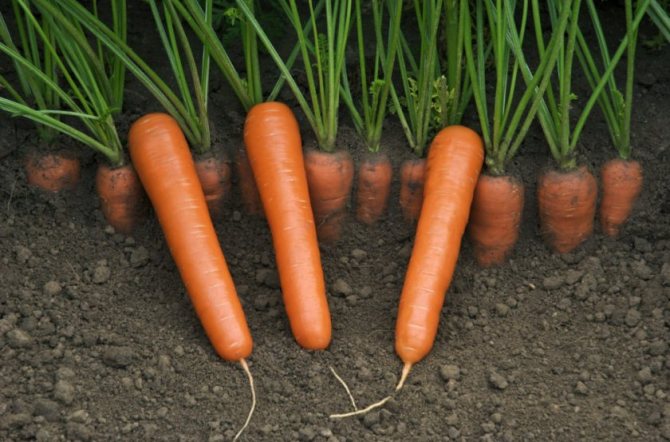

Amsterdam. The tubers are long, the core is thin.Differs in excellent keeping quality, during storage the fruits do not crack. The disadvantage is low productivity.
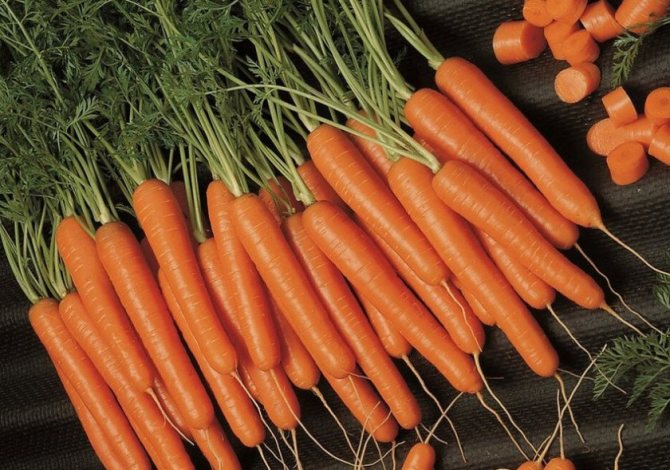

Children's sweetness. Large-fruited, juicy carrot with a sweet, soft core. The color of the vegetable is red, suitable for dietary and baby food.
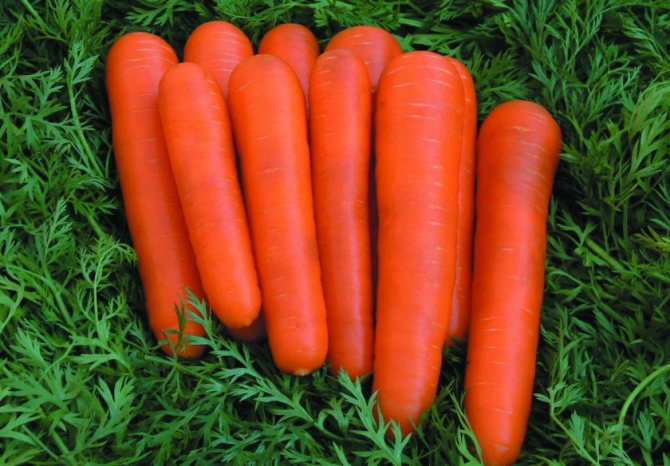

Belgien White. Its fruits have a pleasant aroma.


Bolero F1. Withstands drought and hot days well. The outer part and the core are the same shade of orange. The plant is immune to Alternaria, root rot, cercospora.


Polar cranberry. After the seeds are planted, the crop is harvested after 2 months. This makes the variety suitable for cultivation in harsh climatic conditions.
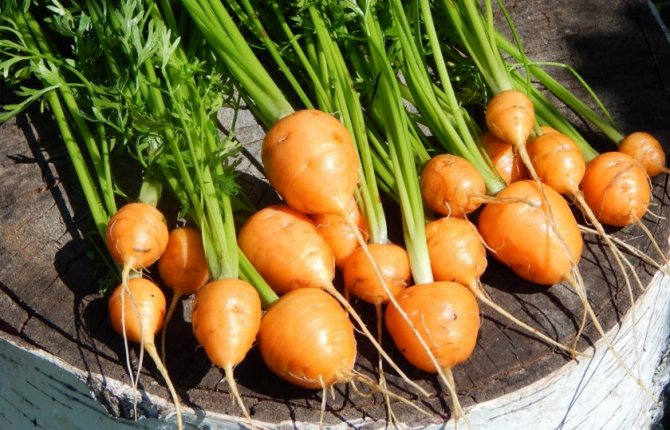

Red giant. Small root crops are not found when growing this variety. The main plus is that the sweetness lasts until March.
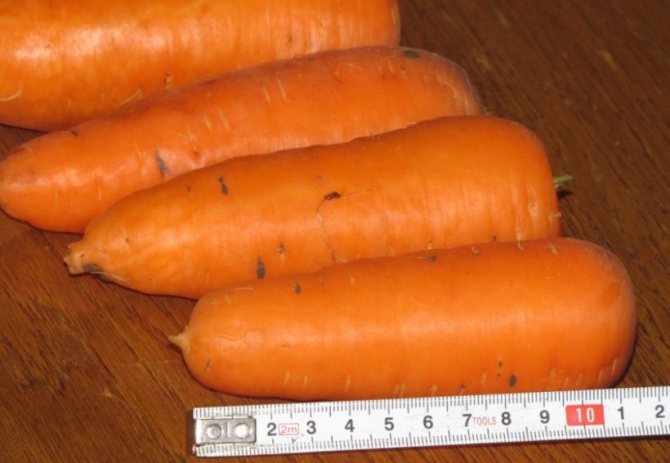

Samson. The fruits can be stored well until spring.
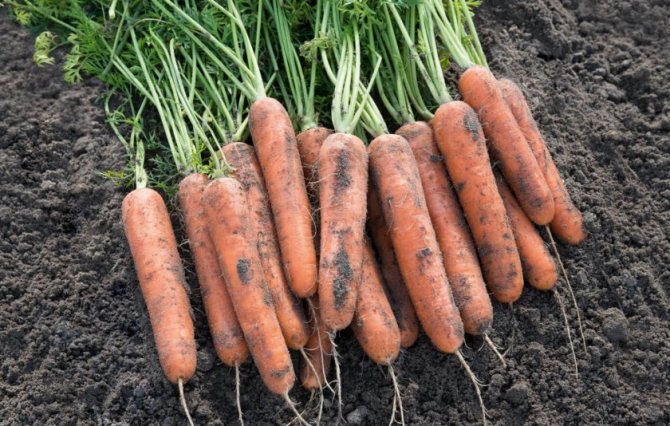

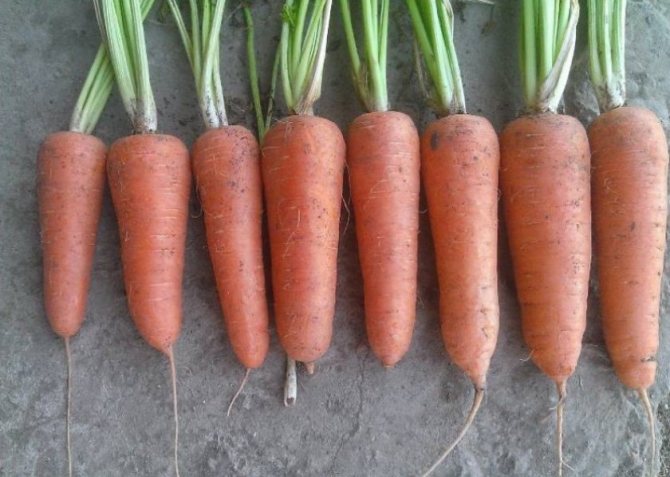

By the degree of maturation
All varieties of carrots are separated by ripening time. They are determined from germination to the state of ripeness of the fruit.
The best varieties of early ripening are:
- Alyonka. A high-yielding variety that takes only 50 days to ripen. The fruits are not too large, only up to 12 cm. The average tuber weight is 100 g. The taste is not sweet enough, but juicy.
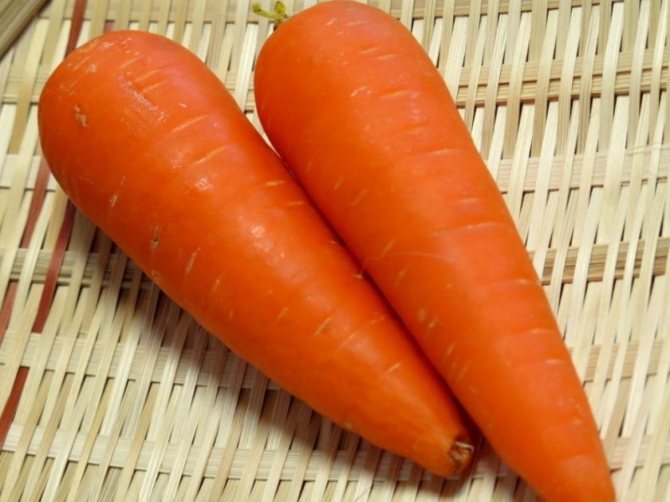

- Touchon. The average fruit weight is 150 g, and the length is 20 cm.
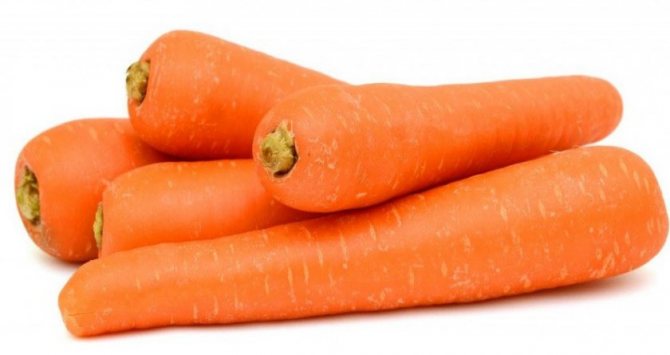

- Carotel Parisian. A hybrid capable of producing crops in heavy, clayey soil. Tubers are small, up to 5 cm in volume and weighing up to 60 g. They accumulate a lot of sugars and carotene. Due to the fact that they are prone to cracking, they are not suitable for long-term storage.
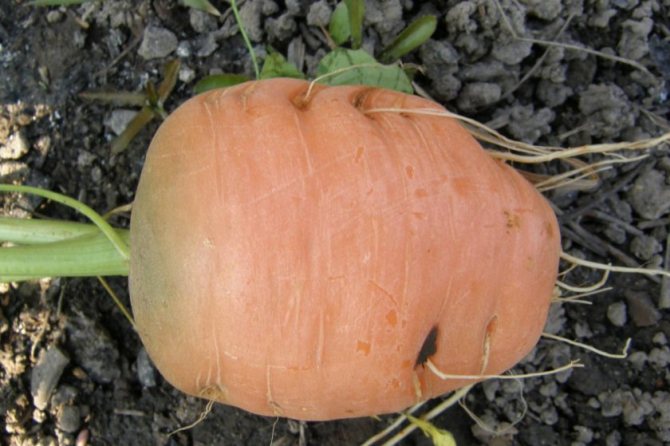

Carrots with an average ripening period are represented by a wide variety of varieties. But the best among them are:
- Losinoostrovskaya 13. Zoned throughout the territory of the Russian Federation, can be cultivated in regions with a short summer. The average ripening period is 110 days. Withstands frosts down to -13 ° C. The length of the tubers is 15 cm, and the weight is 115 g. The tubers are rich orange, which indicates a large accumulation of carotene. The yield reaches 7–7.5 kg per 1 m².


- Nantes. Full ripening occurs 85–90 days after planting. The average weight is 160–170 g, the length is 16 cm.
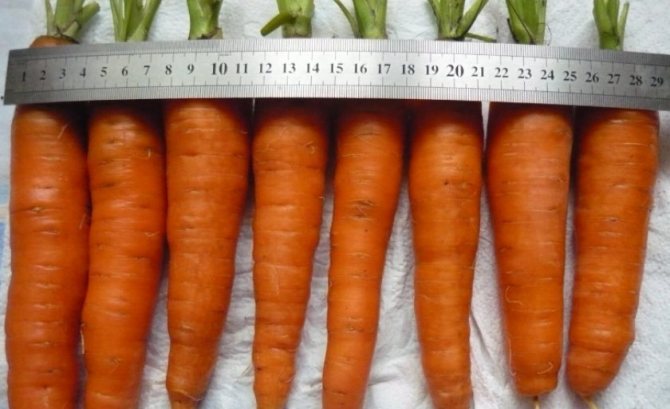

- Moscow winter A515. Left unattended until recently, the variety is now returning to its leading position. It can be planted as a winter variety. Fruits reach 16 cm in length, standard weight - 170 g. Productivity - 7 kg per 1 m². Good keeping quality.


- Vitamin. Fruits are dug up 110–120 days after sprouting. Carrot length - 15 cm, weight - up to 150 g.
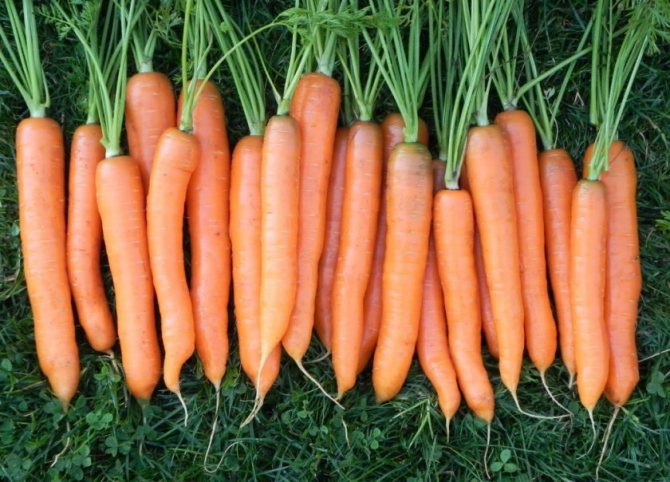

Late-ripening varieties are very well stored, but practically unsuitable for cultivation in difficult climatic conditions.
The best of them are:
- The Queen of Autumn. A young variety entered in the State Register in 2005. Zoned for the middle zone and the Far East. It will take 125 days for the fruit to ripen. Root crops are massive, but very different in parameters (20-30 cm). The average weight is 80–230 g. The pulp is rich orange, almost red. The yield reaches 9 kg per 1 m². The fruits are unsweetened.
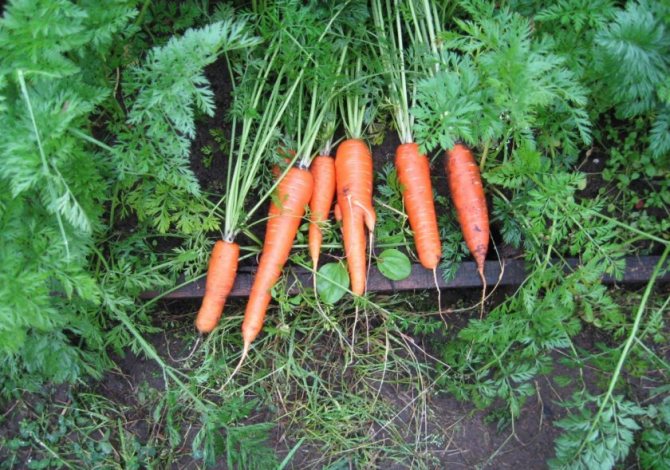

- Red giant. A hybrid with even root crops up to 25 cm long. It will take 150 days to ripen. The fruits are dark orange.


- Flakke. Fruits are harvested 100–122 days after planting. The standard fruit size is 30 cm, and the weight is 150-170 g.


Preparing the soil before growing carrots


It is not surprising, but the yield of carrots depends not only on the variety, the quality of the seed, but also on the cultivation technology. It starts with two stages of preparation:
The soil. The most suitable soil for a carrot field would be a field after legumes or potatoes. The fields after these crops are practically weed-free.The soil for planting carrots should be loose, not clogged and not watery. In the spring, it is necessary to loosen the soil before sowing seeds.
Fertilizers. Fertilize the soil before planting carrots. If you welcome ECO products, then remember that organic fertilizers such as manure are not suitable. It is necessary to fertilize the field with manure no earlier than a year before planting. Before sowing seeds, you can add an aqueous solution of humus. In any case, organic matter must be introduced into the ground before autumn plowing. Phosphorus and potash fertilizers are excellent fertilizers for carrot root crops. The amount of fertilizers is calculated depending on the fertility of the soil. On average, phosphorus fertilizers are used 80-100 kg / ha, and potash fertilizers 150-200 kg / ha. Higher use of potash fertilizers (20-30% more nitrogen) will increase the shelf life of the product. All these types of fertilizers are applied in the fall before plowing.
Cleaning and storage
The grown crop should be harvested correctly and on time - the culture does not tolerate a long stay in the garden, and the fruits lose their juiciness and taste.
Harvesting time depends on planting time and variety. Bunch varieties are harvested in July, and those vegetables that are planned to be stored in winter are dug up at the end of September, when the tops turn yellow.
When collecting, they do not use shovels, but garden forks - this way you can avoid damage to root crops... The dug vegetable is pulled out by the tops, which are immediately cut off with a sharp knife. The green part is cut off completely, leaving no petioles.
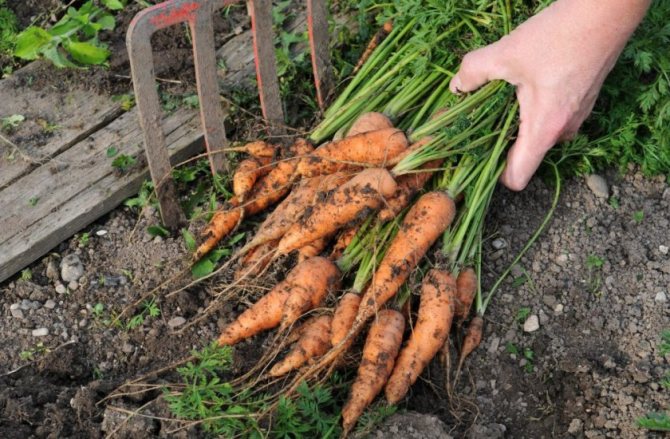

For long-term storage, the following specimens should be selected:
All selected root crops are dried for several hours in the shade, placed in ventilated containers and cooled to 0 ° C. Store vegetables in a dry, cool room, without temperature changes (basement, cellar).
Growing carrots is an exciting and rewarding activity. In most cases, experienced gardeners do not grow only one variety, successfully alternating between sweet, large, early maturing species and late ripening varieties. And knowledge of the main features of growing a vitamin root crop will allow you to get a generous, juicy and tasty harvest.
Many gardeners grow beets and carrots on their land. One of the indicators of the quality of the harvest of these root crops is the sugar content - the higher, the more valuable these vegetables are. There are a number of garden tricks to grow sweet carrots that are easy to follow. Today we will tell you how to feed carrots so that they are sweet.
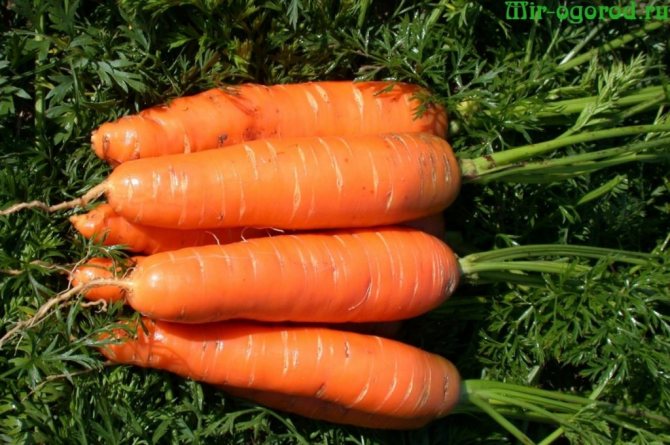

General information
All carrot varieties differ in size, ripening time, keeping quality, transportability and other qualities, therefore, before choosing one or another bag of seeds for the garden, you need to decide for what purpose you are growing carrots. If for sale, it is better to choose varieties or hybrids of Dutch origin, since they are very productive, have a beautiful presentation, uniformity, are well transported and stored. These are in demand among the population. However, because of this, other characteristics of the culture often suffer, for example, their taste is slightly worse, and the content of nutrients necessary for the body is noticeably lower.
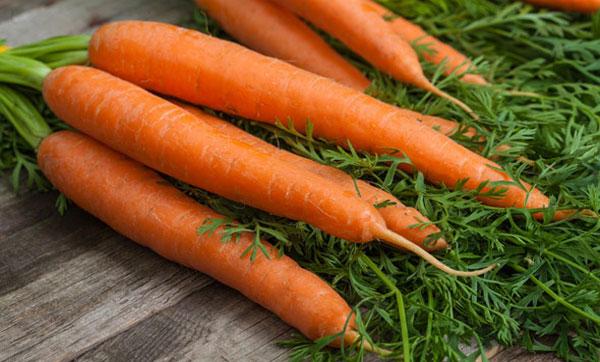

Domestic varieties have a slightly lower yield, root crops may be heterogeneous in size, but in most cases they surpass foreign varieties in taste and usefulness, as well as storage duration. Therefore, for your own use, it is advisable to choose vegetables of domestic selection.
In addition to the traditional orange varieties, vegetables of other colors can be grown: red, white, yellow, purple. They are specially bred, their planting material, if desired, can be found in seed stores.Multicolored carrots are rich in compounds that are not found in common root crops, so growing them in your beds is not only interesting and exciting, but also very useful for replenishing your diet with healthy foods.
Conditions for a good harvest of carrots
Carrots are a frost-resistant crop that can be sown before winter and at several times from early spring. In the southern regions, it is sown in warm winter (February) windows and an early harvest of a delicious vegetable is obtained. Carrots are not afraid of frost.
Fresh articles about garden and vegetable garden
To grow a decent harvest, you need to pay attention to:
- biological characteristics of carrots,
- compliance with the requirements of growing technology,
- soil structure and fertility, its preparation for sowing,
- acidity of soil,
- features of providing moisture.


What carrot seeds need to be sown
In the agricultural technology of carrots, the quality of the seeds and their preparation for sowing are of great importance. Seeds should be healthy, pure-grade, with sowing qualities of only 1st class; germination rate - not less than 70%; purity - 95%, economic germination - 67%. To shorten the period from sowing to the appearance of friendly and healthy seedlings and an early rich harvest, effective techniques are used:
- etching;
- calibration;
- soaking in various solutions;
- pelleting.
Carrot seeds are selected according to the sowing time. For pre-winter and early spring sowing, early and mid-season varieties are chosen (Nantes, Vitamin, etc.). For sowing in spring - late ripening, suitable for long-term storage (Chanton, Moscow winter, etc.).
How to feed carrots before planting
Carrots do not tolerate fresh manure or dung and soil deoxidation. Therefore, it is necessary to fertilize the soil before planting in advance, preferably in the fall, so that the organic matter (most often it is mullein or chicken droppings) is rotted. 6-8 kg of manure, humus or droppings are introduced per 1 square meter. If before that vegetables grew on this bed, which were fertilized abundantly, then there is no need to fertilize more soil.
If necessary, the soil can be slightly deoxidized using the following recipe: add ash, chalk or dolomite flour.
In the spring, you can also feed the seeds before planting instead of fertilizing the soil. Take 1 tablespoon of wood ash and mix with a liter of water, soak the seeds in this solution for a day, and then dry.
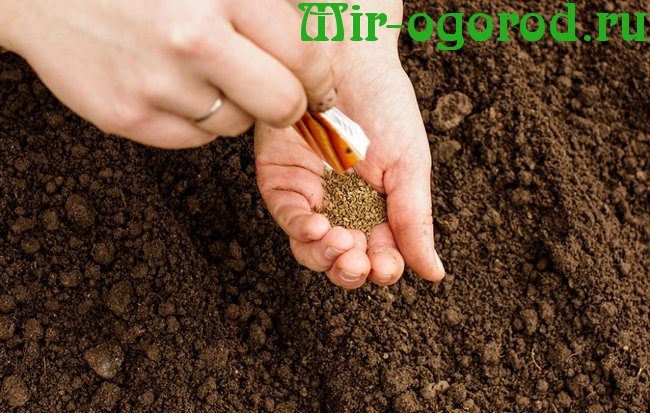

Choice of tax regime
When preparing documents for the future farming, do not forget to choose the right code for your activity and the optimal tax regime. For a farm that plans to grow carrots, of all the codes of the all-Russian classifier, OKVED 1.13 is best suited, and the optimal taxation system, in this case, is the Unified Agricultural Tax (Unified Agricultural Tax).
This regime allows farmers to pay only 6% of the profits, doing this twice a year.
Organic fertilizer for carrots
Carrots are an incredibly sensitive vegetable crop for organic nutrition. Experts strongly advise against bringing in fresh bird droppings or manure. This is fraught with oversaturation of the soil with nutrients. As a result, fertilizer for the growth of carrots can provoke its death.
The root crop can become crooked in shape, and the taste can also change not for the better. Organics are added exclusively in a non-concentrated form.
Chicken droppings. First of all, you should prepare a special infusion: 1 part of organic matter, add 10 parts of water. The final consistency is diluted in another 10 parts of water. The composition can also be added between the rows.
The manure is diluted in water, maintaining a ratio of 1k10. The space between the rows is watered with it.
It is allowed to use foliar feeding based on organic compounds with nitrogen. The consistency is used for spraying tops. Fertilizer for carrots in this case will pass through the plant to the root.This will produce very sweet and nutritious carrots.
Top dressing for carrots is an integral part of active growth for vegetable crops. Taking into account the unpretentiousness of the plant to useful elements, additional feeding will not only increase the yield, but also strengthen it. To get really high quality root vegetables, follow the tips and tricks of the professionals. The correct formation of fruits is achieved by introducing deficient chemical compositions.
Average harvest from 1 are
From 1 weave, you can collect from 0.5 to 1 ton of the crop. At the same time, the yield depends on climatic factors, soil fertility, its aeration and crop care. So, to compare growth and yield, carrots were planted on 2 combs. One of them created the best aeration conditions.
As a result, the following results were obtained:
- the weight of root crops on an improved ridge is 1.9 times higher;
- carrot length - 1.8 times;
- tops length - 1.6 times;
- a higher rate of photosynthesis is noted.
Important! In too hot climates, carrots tend to form very small root crops.
This is why averages do not accurately represent the potential yield for your site. There are many factors to consider.
Mineral and complex fertilizers for carrots
Fertilizers of mineral nature are considered the main ones used for feeding carrots, since this culture does not like organic matter during the growing season, but it grows well and quickly on the site that was fertilized by it last year for the previous crop.
For carrots, you can use simple, blended, or complex mixtures. Each of them can provide vegetative plants with one single nutrient or several at the same time. Of the simple mineral fertilizers for carrots, ammonium nitrate, urea (they contain nitrogen), simple or double superphosphate (will provide plants with phosphorus), potassium nitrate, potassium salt, potassium chloride (they will provide the culture with potassium) can be used commonly used for other vegetables.
The main diseases of table carrots and measures to combat them
Alternaria (black rot) - strict adherence to the cultivation technology.
Sclerotiniasis (white rot) - use for sowing resistant varieties.
Botrytis (gray rot) - avoid thickened crops.
Fomoz - avoid increased application of nitrogen fertilizers.
Cercosporosis - soil disinfection is practiced in some countries.
Bacteriosis - compliance with crop rotation.
Powdery mildew - Carrying out liming of acidic soils.
Common scab - removal of infected plant residues from the field.
Blackleg - watch out for over-watering.
How to feed carrots so that they are sweet
You need to know what kind of fertilizer for carrots will add sweetness when planting. According to many gardeners, this is ash. It contains potassium, which affects the taste. Ashes can be brought in for digging, or you can dust the plantings with it after each watering. In this case, two birds with one stone are killed.
The first is to supply the plant with potassium, the second is to protect it from carrot flies. The benefits of ash don't end there. Practice shows that by introducing this fertilizer for carrots when planting in a hole, they improve the keeping quality of root crops.
It's not just fertilizers that make a vegetable sweet. It turns out that the right watering can add sweetness to her. The frequency of watering is individual, depending on the structure of the soil. For example, if your soil is light (sandy loam) in your garden, then you water every week and very abundantly. Another option: the soil is fertile, oily. In this case, watered every week, but little by little.
Fresh articles about garden and vegetable garden
After the first thinning, do not water the ridge for 3 weeks, it will grow down in search of moisture.
It is necessary to feed carrots. This is necessary for full growth, nutrition, increased vitality and immunity.The appearance, taste and shelf life of carrots depend on the correct and timely fertilization.
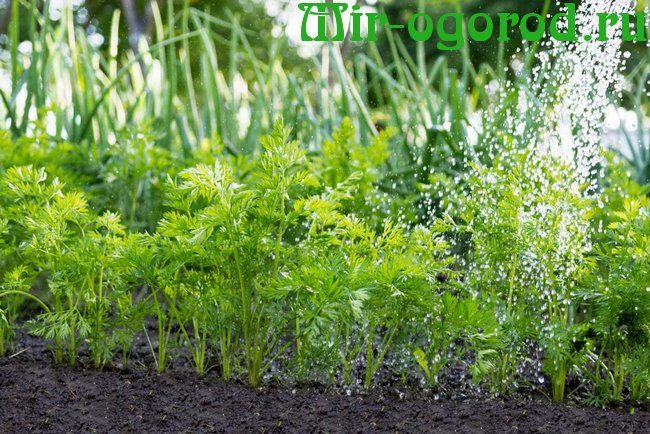

Carrots do not tolerate weeds
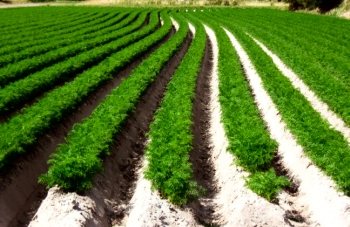

When growing carrots, the most difficult task is the weeds. They can be avoided by growing without weeding while avoiding the use of herbicides and other harmful chemicals. Moreover, there are even 2 options:
- Application of black film. The entire area is covered with a special black film. Holes are made in it through which seedlings grow, and nothing grows under the film. The film itself breathes and perfectly permeates water during rainwater irrigation.
- Sawdust. Sawdust is strewn between the rows of seedlings. They inhibit the growth of weeds, reflect excess sunlight and retain moisture. In addition, sawdust rotted and fertilized the soil.
But on top of that, you should take care of prevention. The ascent time of the first carrot sprouts is quite long, and in some varieties it reaches a month, but weeds appear as soon as I feel the first warm rays of the sun. Naturally, weeds can be taken care of even before sowing seeds, but herbicides are often used for this. A great alternative to herbicides and human labor is soil mulching.
Mulching the soil means covering the entire planted area with free-flowing mulch. Mowed grass can be considered mulch, only here you need to avoid getting grass with seeds, peat, garden compost, as well as dark plastic wrap. This method is also good in that it will help to retain moisture in the ground for longer and reduce the amount of watering. Mulching is carried out in the fall. In the spring, the beds are made either on mulch, or, by moving it to the sides, it is possible to cover the beds themselves with mulch only when the plants rise 5-7 cm from the ground.
How to feed carrots with ash
Feeding the culture with ash is best done during the intensive growth of root crops, that is, during the third feeding. Ash is a potash fertilizer that is better absorbed by plants than others. And it also perfectly protects the crop from pests and diseases. In July-August, once every 10 days before watering, you can simply dust the carrot beds with ash.
For watering with infusion - 1 glass of ash is thoroughly mixed in 10 liters of water and, not allowing to settle, water the beds.


There is no unequivocal answer to the question of which fertilizer: mineral or organic, is better suited for carrots. Each of them performs its own function. Organic matter in the form of compost or humus is usually introduced in the fall when preparing the beds. Mineral fertilizers, together with organic fertilizing, are applied by root or foliar method. For a vegetable grower, the main goal is to get a rich and environmentally friendly harvest of orange root crops. If fertilizers are applied at the rate, in a timely manner, then the tandem of mineral fertilizers and organic matter will help achieve the desired result.
If you want to see a vitamin vegetable on the table all year round, then follow the recommendations of vegetable growers for caring for carrot beds. Do not neglect the procedures for thinning and feeding carrots. After all, the taste properties, presentation and keeping quality of the future harvest depend on the correct fertilization procedure.
There can be many reasons why carrots are not tasty. It is quite possible to avoid such an incident if you follow some agrotechnical rules.
Carrots are a vegetable that grows almost all over the land. There are about 60 types of this root crop, differing in their size, color, and the purpose of growing. The uniqueness of the carrot is due to the possibility of its use even at the growth stage, during the period of intensive watering, as well as the prospect of planting seeds even on the balcony, creating an impromptu bed in a flower box, if the earth is fertilized in advance.
Sowing carrots in the ground
The beds, before sowing, are watered with hot water. It is advisable to dissolve Fitosporin in it.Then the soil is covered with a film - so that it retains moisture and warms up.
Distance between seeds
Carrot seeds are buried by 2-3 cm, having previously made shallow grooves - 2-3 cm deep. It is impossible to sow deeper - the germination time is already protracted, it will be even more postponed. And if you sow less deeply, you can completely lose seedlings. The recommended spacing between adjacent seeds is 1 to 3 cm, the optimal distance is 2 cm.
The grooves into which the seeds are sown are watered and then sprinkled:
- wood ash is a potash fertilizer;
- tobacco dust - it saves from pests.
Carrot seeds are very small, so sowing them is painstaking and slow. If you sow hastily and generously, then later you will have to break through the carrots - seed material is wasted. In addition, when thinning overly thickened plantings, thin seedlings can be damaged.
Scheme for planting carrots in the open field
The scheme depends on the scale of the planting:
- For industrial cultivation, carrots are planted in double rows, between them - 15-20 cm. Between adjacent ridges - 40-50 cm.
- At small scales, the width of the ridge is 1.3-1.5 m. The rows are made perpendicular to the long side of the garden. Due to the small width of the bed, the rows are convenient to weed, water and thin out from either side. The distance between the rows is 15-20 cm. Beads are made along the edge of the beds so that the water does not drain during irrigation.
Do I need to water the carrots after planting?
The sown seeds are covered with fertile soil and compacted by hand to ensure good contact with the soil. Watering crops depends on the weather:
- Carrots are planted early, while the soil is still wet, and if it is damp and cool outside, then there is no need to water the plantings.
- In warm sunny weather, it is recommended to water the crops a little. But this must be done carefully and moderately - so as not to provoke the formation of a crust. It is advisable to mulch the crops after watering, then the crust will definitely not form, and the seedlings will easily break through to the surface.
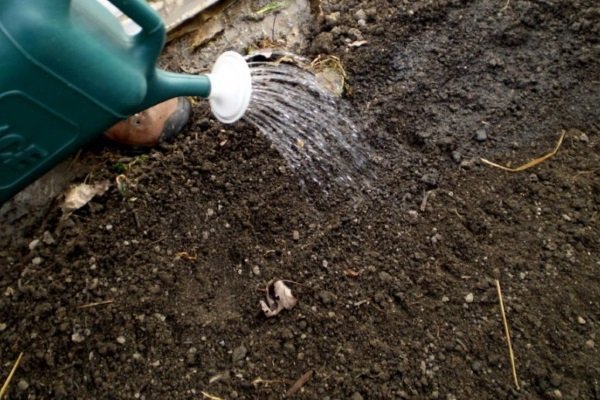

To preserve moisture and accelerate the emergence of seedlings, the crops are covered with foil or spunbond. The latter is preferable - it may be too hot under the film, and the seedlings will burn. As soon as the seedlings appear, the covering material is removed.
Light watering - spraying, repeat daily until shoots appear. When the carrots rise, the aisles are loosened, and watering is halved. Until the aisles are closed by the tops, they are regularly loosened so that they do not become overgrown with weeds.
How many carrot seeds sprout?
Under favorable conditions - if the weather is warm, and the seeds were planted soaked, seedlings will appear in about a week. At temperatures below +12 ° C, the germination time is doubled - the first shoots will break through no earlier than two weeks later.
Description of carrots
Carrots are used not only in cooking, but also in medicine and cosmetology. The presence of a large amount of phytoncides in this plant makes it possible to disinfect the oral cavity and strengthen the gums. At the same time, a mixture of chopped carrots and egg yolk stimulates hair growth, perfectly cleanses the skin and gives it a healthy tone. The root vegetable is edible in any form, and a glass of juice from it compensates for the lack of a daily dose of vitamins and minerals.
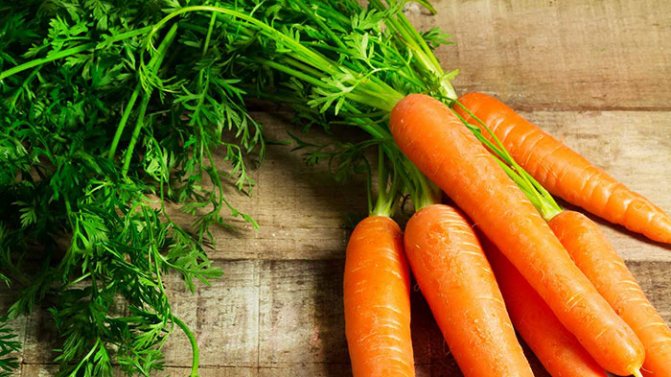

Although carrots are 87% water, they can provide the body with protection against diseases:
With frequent use of carrots, you can relieve the symptoms of polyarthritis, diabetes, increase the regenerative capacity of the body,
Due to the large amount of growth-promoting vitamin A in carrots, its use is especially indicated for children. And, although the kids for some reason treat her negatively, you can deceive them by making weekly juice from sweet carrots with banana and strawberries. A child can hardly refuse such a healthy and tasty dessert, which is guaranteed by root vegetables, gradually he will fall in love with carrots.
Realization of grown root crops


The demand for carrots is quite stable all year round. This vegetable is very useful, it is rich in vitamins, macro and microelements. The main and best known vitamin in carrots is vitamin A (beta-carotene). Every person knows about the benefits of this vitamin since childhood.
This root vegetable is eaten both raw (salads) and in various dishes requiring heat treatment, and every housewife will always find this useful vegetable to be used in her kitchen.
Even small carrots are selling well today. For example, the famous "Baby carrots", they were invented by Mike Yuroshek, who is tired of selling tiny fruits for feed. He made them popular and in many schools it is no longer possible to imagine breakfast without these healthy Baby carrots. The idea of how successful it has become that today even breeders are breeding a special Baby carrots variety. In stores, these small root vegetables are sold even canned like peas.
Unpalatable carrots - reasons
What is the amazement of gardeners when, sown in the usual way in the garden, always before that sweet carrot suddenly refuses to grow, and after harvesting it turns out to be completely tasteless and even bitter. Why carrots are tasteless there can be several reasons:
- Lack of potassium and phosphorus in the soil layers. Fertilizers are compensated for by applying in the fall to the place of spring planting. This also leads to the ugly shape of the root crop of the selected variety.
- Forgetfulness to treat the garden in August with manganese sulfate, which significantly sweetens the roots, increasing the content of sugars and carotene in them.
- Applying 25-30 days before harvesting a nitrogen-rich fertilizer is also an important reason. Carrots accumulate nitrates and lose their flavor.
- Late harvesting of carrots, rare thinning. Being in the soil for more than the prescribed period, the root can lose its taste.
- Influence of pests, in particular - carrot flies. This is bad, but they learned to fight them a long time ago with the help of a bow. The beds of these plants are placed side by side or they are sown through a row, you do not need to water them too often
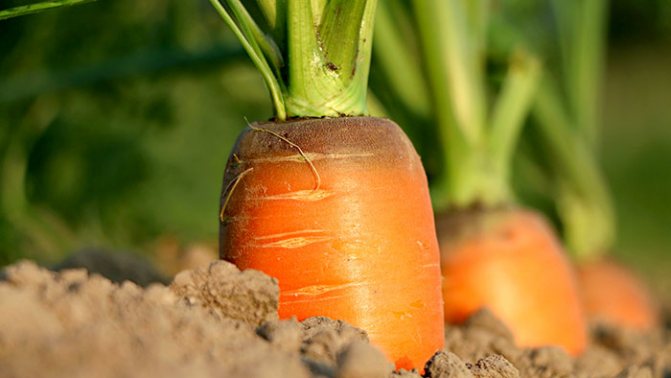

In addition, no matter how tempting it is, you should not be guided by the picture and purchase the seeds of F2 hybrids. As a rule, they exhibit the characteristics of wild carrots, are a less valuable nutrient, and you cannot correct their taste with fertilizers.
The presence of elements of bitterness, slightly "herbal" taste of carrot food is inherent in varieties intended for long-term storage. They manifest themselves only 2-3 weeks after digging out of the ground.
Experienced gardeners advise to huddle the beds in a timely manner. Being above the soil level, the upper part of the root crop acquires a bitter taste and turns green. In the first months of summer, carrots need frequent watering, if the ground is dry, the amount of moisture decreases as it ripens.
Mistakes of inexperienced vegetable growers
- Like all vegetables, carrots are light-requiring, therefore, if you plant root crops in the shade, they will grow very short (3-5 cm), and the yield will decrease by half or three times. With excessive moisture in the soil, carrot roots get sick, therefore, in an area where groundwater is close, beds should be made 30-35 centimeters high.
- If the beds are poorly plowed on dense, poorly cultivated soils, the carrot grows in an ugly shape, branches, its quality and yield in general decrease.
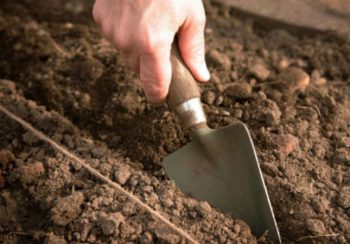

The soil for carrots should be prepared in the fall.
The sweetest carrot varieties
The reason why carrots are not tasty may be the wrong plant variety. After all, not all root vegetables of this type have the same amount of sugar and carotene. The sweetest varieties of carrots with the maximum amount of these substances are recognized as:
- Maestro F1 is an early ripening hybrid that develops in any climatic conditions if it is watered frequently. The color of the carrots is bright orange, the shape is cylindrical, the core is light red.Root crops are disease resistant.
- Children's sweet - grows up to 20 cm, is characterized by juiciness, tender and very sweet core. The root vegetable is red, suitable for dietary and baby food, grows well.
- Emperor - reaches ripeness late, is distinguished by a bright orange color, a small heart. When the appropriate conditions are created, the presence of moisture, the hilling of the beds, it is stored without loss of appearance and taste, until early spring.
- Bolero F1 - root crops easily tolerate drought, heat, their outer shell and core have the same bright orange hue. Carrots are immune to powdery mildew and Alternaria, being in the ground, they resist root rot, cercospora.
All seeds, regardless of variety, need standard maintenance methods and frequent watering.
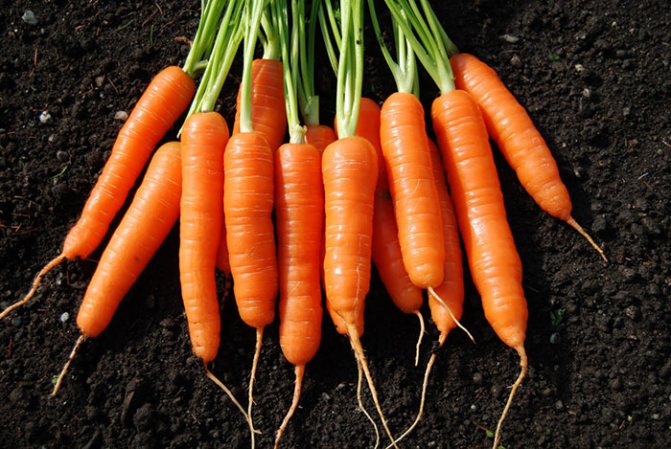

Some interesting facts
When buying carrots in stores or in the market, most people instinctively choose the largest root vegetables. You should not do this, because they accumulate a large amount of nitrates. The most optimal in terms of size are 150 g carrot samples, containing a maximum of vitamins and minerals and very few harmful substances.
Carrots miraculously help you get an even tan on the beaches or in a solarium, if you drink 200-250 g of freshly squeezed juice just before going there. The same remedy helps relieve stress, calm the nervous system, and also speed up the recovery of the dermis after surgery, burns or visiting a beauty salon.
Growing technology. How to prepare the ground?
Experts advise not to forget that during the construction of carrots, the amount of root crops and the volume of the harvest largely depends on how deeply the land is plowed. If the depth is large, then you should expect smooth, long, even root crops that have an attractive presentation. Thus, in order to get the maximum amount of carrots of an attractive appearance, it is worth plowing as deep as possible in the autumn period, you can even use an additional deepening.
Construction methods
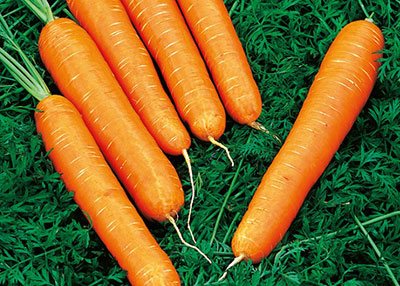

The number of seeds during planting depends entirely on the purpose of the ripe carrots. To get an early harvest, you need to sow about 3 million seeds per hectare. To get carrots for storage and sale in the form of fresh root crops, you need to sow no more than 2 million seeds per hectare. To obtain carrots for processing or storage, no more than 1.3 million seeds need to be sown per hectare.
The number of seeds for sowing carrots that are intended for processing depends on the type:
- varietal seeds - 1 - 1.2 kilograms per hectare;
- hybrid seeds - 0.85 - 0.95 million seeds per hectare.
The seeds should be sown into the soil to a depth of no more than 2 centimeters. To ensure that the root crops are approximately the same in size, experts recommend using a precision seeder, with which the seeds will be evenly distributed in the soil.
If the carrots are intended for fresh sale or for industrial use, then you need to choose the number of seeds and method of cultivation that will lead to a harvest of the most attractive type and desired type. The best way is two-row seeding on the ridge, while the width between the rows should be about 70 centimeters. Modern seeders allow sowing carrots with a new method - in three rows, while the width between rows is from 65 to 75 centimeters. To use the mechanical method of eliminating the upper, deciduous part of the carrot, you can sow in one row, and leave the width between the rows no more than 45 centimeters. In cases where harvesting is done with a knife harvester, and the tops are removed automatically, then 95 percent of the harvest is done without the use of manual force.
The sowing time of carrots also depends on what the root crop will be grown for. To get an early harvest, we will be optimal at the earliest sowing time - around March, when it becomes possible to go out into the field. To get carrots that will go for storage, you need to plant the vegetable a couple of weeks later, this will not allow the crop to overripe and overgrow.
How to protect crops from weeds?
Protective agents against unwanted plants are used only if this is provided for by the carrot protection system in connection with the timing of the collection of root crops. If the carrots are grown for bunch sale, then the remedies are applied before the carrots emerge.
If the weeds have not removed, then it is necessary to re-process after the plants release at least a couple of full-fledged leaves. You should know that it is best to process crops in the evening, without wind and at temperatures from 10 to 25 degrees.
Diseases of carrots
Fields with planted carrots must be protected from all kinds of diseases. Plantings that are affected by infections and diseases cannot be removed mechanically, and the crop will not be preserved for a long time. It is in order to avoid contamination that the field must be kept clean until harvest. First of all, crops must be protected from the most dangerous diseases for carrots - powdery mildew and Alternaria.
Pest types
The greatest danger to carrots is the moth and carrot fly. To protect plantings, you need to use seeds that are treated with special chemicals. The second treatment is carried out around the end of May, at which time the flies attack carrots most actively. If two treatments are not enough, it can be repeated every two weeks, and if there is an increased activity of pests, then the treatment can be repeated every two to three days.
To fight diseases, unwanted plants and insects, you need to use only those preparations that are recommended for the region in which the vegetable will be grown. Experts who are versed in such drugs can give detailed recommendations and advice.
Harvesting
During the harvest of carrots, the main thing that must be closely monitored is that the roots do not have time to dry out. This is true for both manual and mechanical methods of collecting root crops. When the harvested carrots dry out, their shelf life is significantly reduced, and the quality decreases. The carrots that are intended for storage can be harvested both manually and mechanically, but the root crops intended for processing are harvested exclusively by a combine harvester.
Storage secrets
In order to keep carrots in the proper form for as long as possible, you need to plant seeds intended specifically for storage. At the same time, the harvested vegetables should not be dry, they should be healthy, without traces of pests.
One of the most popular storage methods is stacking in kagatami, however, with this method it must be remembered that the temperature in the kagatami should not exceed 1 degree Celsius. Among the main advantages of this type of storage is its low cost. The disadvantage is a large loss of production. The optimal way of storage is the use of vegetable stores and refrigerators, it allows you to keep most root crops in proper form, in addition, refrigerators and vegetable stores allow you to cook carrots regardless of weather conditions, which has a beneficial effect on the overall storage duration. This method involves storing root vegetables in a box, at an ambient temperature from zero to minus one degree and at a humidity of about 95 percent.
The financial part of the business plan


Any business involves drawing up a business plan with accurate calculations, making money on growing carrots is no exception.Calculations will help determine the amount of funds that will have to be invested at the start, and the estimated revenue from the sale of vegetables. By comparing the numbers, the entrepreneur will find out whether it is profitable to do this business.
Investment and monthly expenses
Consider how much you need to invest in a business if an entrepreneur uses a leased plot of land with an area of 1 ha. Project investments include expenses (in rubles):
- paperwork - 800;
- land lease for 4 months - 24,000;
- purchase of equipment - 60,000;
- purchase of seeds - 15,000;
- fertilizers, means for treating the site from pests - 10,000;
- other expenses - 10,000.
The total amount is 119,800 rubles. This does not include the cost of buying a car. It is assumed that the business owner already has a vehicle.
This figure is approximate, since the cost of renting agricultural land in different regions differs. The final amount also depends on the selected seed variety - Dutch hybrids are 2-3 times more expensive than domestic carrot varieties.
Monthly expenses include:
- workers' wages - 80,000;
- expenses for the purchase of fertilizers - 10,000;
- other - 5000.
In total, 95,000 rubles will be spent during the carrot growing season.
Sales revenue and profit calculation: how much you can earn
If the year turns out to be fruitful, it will be possible to harvest 20-25 tons of carrots from 1 hectare. Wholesale buyers offer for 1 kg of vegetables from 13 to 17 rubles, the price depends on the quality of the fruit - variety, commodity characteristics. Selling root crops in small wholesale, for example, to school and preschool institutions, to markets, you can get more money - at 18–20 rubles per 1 kg.
Let's make the calculations:
25,000 kg x 17 rubles (average selling price) = 425,000 rubles. The resulting figure is the revenue from the sale of carrots. To find out what the profit is, you need to subtract the initial investment in the project and current expenses for the season, as well as 6% of tax deductions from this amount:
425,000 - 119,800 - 95,000 = 210,200 - 12,612 (tax) = 197,588 rubles.
So much can be earned by growing carrots from a land plot with an area of 1 hectare. In practice, the profit may be 15-20% less, since part of the crop will be of poor quality and it will be possible to sell it at a bargain price... Calculations show that it is more profitable to rent a larger plot of land - at least 3 hectares, in order to reach an income level of about 500,000 rubles per season.
Growing carrots as a business is a profitable undertaking. However, this way of making money is quite specific and not suitable for everyone. Reaping a good harvest requires more than just purchasing the best seeds. The profit in this business depends on the composition of the soil on the site, the quality of plant care, compliance with sowing dates, and weather conditions. This business can only be done by those who have been engaged in agriculture for a long time. A person with no experience in gardening runs the risk of losing their investment.
Organizational plan
The organization of a carrot growing business involves its legalization and includes several stages of work:
- search for a suitable site;
- purchase of equipment;
- selection of carrot varieties and purchase of seeds;
- search for workers who will work in the field;
- sowing and growing crops;
- harvesting;
- search for wholesale buyers for finished products.
Activity registration
To be able to wholesale root crops, you need to legalize your activities. Registration of an agricultural business involves the creation of a peasant farm. A farm can be organized by one person or a group of people.
Step-by-step instructions for registering a peasant farm:
- draw up a statement on the establishment of a peasant farm;
- bring in the tax passport of the future head of the economy and his photocopy;
- pay a state fee of 800 rubles and attach a receipt to the documents.
If a farm is created by a group of people, one more document will be needed - an agreement of the participants on the creation of a farm.In this case, the tax inspector will require passports and copies of all members of the farm.
Registration documents for peasant farms will be ready in 5 days. Such activities are subject to the uniform agricultural tax. The rate is 6% of the profit.
Land search
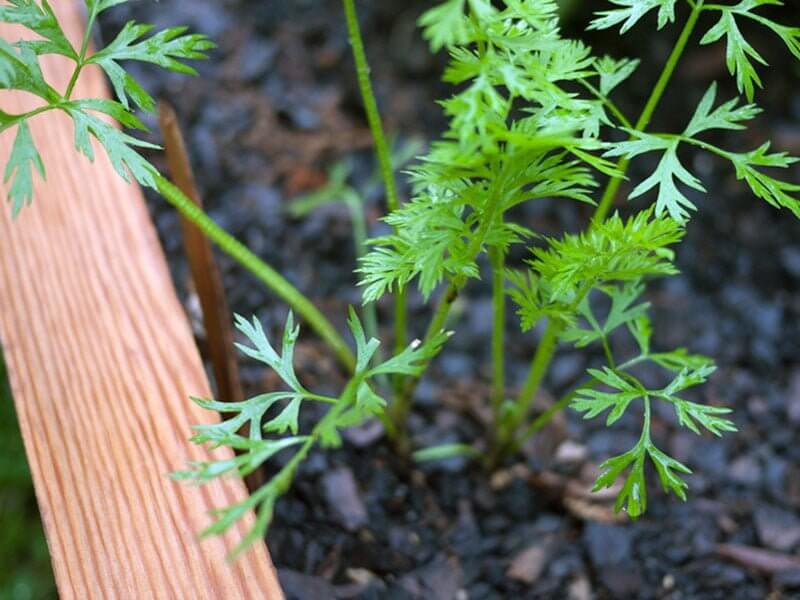

One of the important stages of starting a business is finding a piece of land for growing carrots. The desired area is at least 2 hectares, and if the budget allows, it is better to rent 5 hectares. Ideally, if there is a water source nearby - a natural reservoir or a well. Otherwise, you will have to spend money on creating an artificial irrigation system.
Equipment
A significant part of the investment will go to equipment. You will need not only equipment for cultivating the land and carrying out harvesting works, but also a car. It will transport workers to and from the field.
Other Necessary Technique:
- walk-behind tractor;
- hiller;
- seeder;
- digger.
Equipment costs will not exceed 60,000 rubles if the entrepreneur already has a car. If not, you will have to buy. A used vehicle is cheaper than a new one. It is important to choose a car that is in good condition on the go. It is also worth considering that it will have to drive off-road.
It is better to give preference to a domestic SUV of the "Niva" type. The cost of such a car ranges from 100,000-250,000 rubles, the price depends on the condition of the vehicle, year of manufacture, mileage.
Staff
Workers will be needed to care for the crop. They will huddle and weed the beds, apply fertilizers, and treat plants from pests. It is impossible to cope with such work alone, even if the area of the site does not exceed 1 hectare. The number of employees is determined individually. To cultivate 10 acres of land, you will need to hire about 3 people.
Choosing a variety of carrots for growing and purchasing seeds
A businessman needs to choose the varieties of carrots that he wants to grow. Preference should be given to two varieties - early and late maturing. Early carrots are planted either before winter or in spring, as soon as the topsoil warms up. It is not intended for long-term storage, but such fruits can be sold at a high price.
Late carrots have good shelf life. It can be sold throughout the winter if there is a storage cellar. Consider which varieties are popular with vegetable growers.
Early carrots
This group includes varieties with a short ripening period - from 85 to 100 days. It is worth allocating 15–20% of the plot for planting early carrots. Although the yield will be low, this disadvantage is compensated by the increased cost of goods.
Early maturing varieties and hybrids:
- Artek;
- Rex;
- Canning;
- Parmex;
- Nantes;
- Callisto;
- Touchon;
- Nandrin.
Mid-season and late carrots
This group includes varieties with a ripening period of 100 to 125 days. The yield of late carrots is higher, the fruits contain more sugars, and the vegetables themselves are stored for a long time. The following varieties are popular:
- Shantane 2461;
- Autumn Queen;
- Canada F1;
- Comet;
- Ascona;
- Salsa;
- Samba;
- Amsterdam.
The table shows the varieties of carrots that are suitable for growing in the Moscow region


Having decided on the variety, you need to buy seeds. According to experienced gardeners, it is better to give preference to the products of well-known agricultural firms that have managed to recommend themselves well. The yield depends on the quality of the planting material. You cannot save on seeds. It is better to choose those that have already been calibrated and processed with compounds that increase crop immunity and germination.
Reference. About 3 kg of seeds are used per hectare of land. Their cost varies between 5000-12000 rubles per kg. The most expensive are Dutch hybrids.
Sowing work
First you need to prepare the site for sowing. Carrots bear fruit well on light to medium loam or cultivated peat soil.The beds are dug in advance to a depth of 20–25 cm and peat, superphosphate, urea, rotted leaves and wood ash are added. If the soil is acidic, liming by adding dolomite flour is recommended. Immediately before sowing, the beds are moistened.
The seeds are deepened into the prepared furrows to a depth of 3 cm, keeping a distance of 5–6 cm between them. A denser sowing involves the thinning of carrots in the phase of appearance of 3-4 leaves. Landings are crushed with loose soil.
Harvest
The yield of carrots depends not only on the varietal affiliation of the culture and the quality of care for it. This indicator is influenced by weather conditions, lack of sunlight, soil structure and other factors. It is important to adhere to the technology of growing carrots. Common mistakes inexperienced gardeners make:
- Planting crops in the shade. This leads to crushing of the fruit.
- An excess of organic fertilizing and nitrogen contributes to the deformation of root crops.
- Carrots growing on dense, poorly plowed soil change shape, bifurcate, and lose their presentation.
Harvesting begins in late summer or early autumn. The timing depends on the length of the growing season of the selected varieties. Root crops are harvested by hand after processing the beds with a digger. Then they are cleared of the ground, slightly dried under a canopy and sent for sale or storage.
Attention! An average of 20 to 30 tons of carrots can be harvested from one hectare of land. At large agricultural enterprises, this figure is 2–2.5 times higher.
Yield care
It is quite easy to take care of carrot crops, it is unpretentious in care. It is enough to follow the seedlings in time and water. If you notice that the seedlings are too rare, then you need to sow seeds of medium early varieties between them. In the case of too thick greens, it is better to thin them out. Cut off seedlings can be used for compost, but they should not be left near the beds, as their smell can attract harmful insects.
Do you take care of carrots somehow?
No, maximum weeding Yes, fertilization is a must
Water your carrot crops every day if the weather is hot. In cloudy weather, it is enough to water once every 5-7 days. It is better to water the beds in the evening. In the morning, it is necessary to loosen the soil between the beds so that a hard crust does not form.
If the seedlings are weak and rare, then after a couple of weeks you can feed them with nitrogen fertilizer. It should be added to wet soil. Mandatory feeding must be done 1.5-2 months after planting. The fertilizer must contain superphosphates and potassium.



